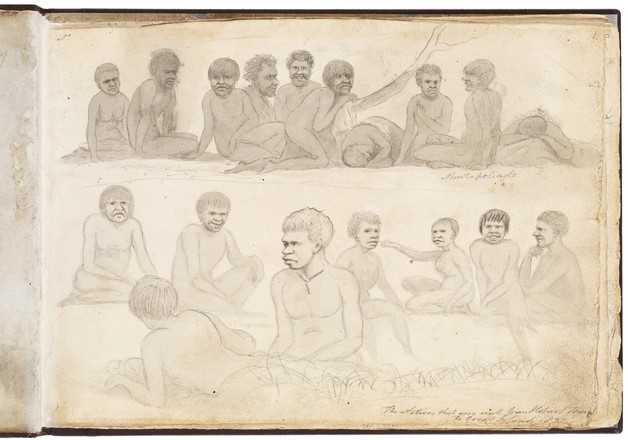The natives that were sent from Hobart Town to Great Island 1832
1832
Pencil, pen, ink and wash drawings on wove paper
Bequest of Sir William Dixson, 1952
DL PX 46
In 1831 the highly successful English landscape artist John Glover emigrated to Tasmania (then Van Diemen’s Land) to join his two sons already living there. Arriving on his 64th birthday, he looked forward to a ‘new beautiful World – new landscapes, new trees and new flowers, new Animals, Birds, etc. etc. is delightful to me’ [1]. Yet he also arrived at a time when the conflict between Aboriginal Tasmanians and the colonists was at its height.
John Glover has been described as a charming man of excellent spirits: cheerful, mischievous, eccentric, even-tempered, gregarious, energetic and adventurous. Glover appears to have been eager to make contact with the Palawa, the Tasmanian Aboriginal people. He made efforts to learn and record the names of those he met, and in his paintings he depicts them as peaceful, happy people: a catalogue note to one of his Corroboree pictures comments: ‘one seldom sees such gaiety in a Ball Room, as amongst these untaught Savages’ [2].
A multitude of wrongs
Speaking to George
Augustus Robinson, who had been appointed by the governor to ‘conciliate’ with
the Aboriginal people, Oyster Bay chief Tukalunginta said that the violence
which erupted in Tasmania resulted from his people being ‘cruelly abused, that
their country had been taken away from them, their wives and daughters had been
violated and taken away, and that they had experienced a multitude of wrongs
from a variety of sources.’* But the Hobart
Town Courier of 14 January 1832 declared that the ‘removal of these blacks
will be of essential benefit both to themselves and the colony. The large
tracts of pasture that have been long deserted owing to their murderous attacks
on the shepherds and stockhuts will now be available…’*
Footnotes
*Tasmanian
Aboriginal Centre, Mumirimina People of
the Lower Jordan Valley: Draft History Report, 2010
The wild woods of country
Following
what are often known as the Black Wars – the fight by the Aboriginal
inhabitants of Tasmania to defend their lands from Europeans – many Europeans
began to romanticise the tribal life they had just decimated. John Glover often
included Aboriginal people in his Australian landscapes, even though they had
been effectively removed from Tasmania by the time he was painting there.
Indeed Glover told George Augustus Robinson, who had been responsible for the
successful attempts to remove Aboriginal people from their tribal lands, that a
painting of a corroboree he made for him was to show ‘the Natives … under the
wild Woods of the Country – to give an idea of the manner they enjoyed
themselves before being disturbed by the White People’.*
Footnotes
* John
Glover to GA Robinson, 7 July 1835, Robinson Papers, Mitchell Library, A7043
A controversial figure
George
Augustus Robinson is one of the more controversial figures in Australian
history. Arriving in Hobart in 1824, he accepted a government position which
had been established to mediate peace with Tasmania’s diverse Aboriginal
population. Robinson embarked on a number of expeditions across Tasmania to
seek out tribes and negotiate their removal to Flinders Island, where most died
soon after they were taken there.
Through the
force of his personality, Robinson positioned himself as a colonial celebrity.
He was also a keen observer and kept detailed accounts of his activities and
the people, events and places he encountered. Robinson’s journals,* now in the
Library’s collection, provide a valuable record of Tasmania’s Aboriginal people
and culture, and of the history of its colonisation.
Footnotes* George Augustus
Robinson papers, 1818–1924, Mitchell Library A7022–92



 Back to list
Back to list